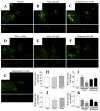Assessment of newly synthesized mitochondrial DNA using BrdU labeling in primary neurons from Alzheimer's disease mice: Implications for impaired mitochondrial biogenesis and synaptic damage
- PMID: 21549836
- PMCID: PMC3143239
- DOI: 10.1016/j.bbadis.2011.04.006
Assessment of newly synthesized mitochondrial DNA using BrdU labeling in primary neurons from Alzheimer's disease mice: Implications for impaired mitochondrial biogenesis and synaptic damage
Abstract
The purpose of our study was to assess mitochondrial biogenesis and distribution in murine primary neurons. Using 5-bromo-2-deoxyuridine (BrdU) incorporation and primary neurons, we studied the mitochondrial biogenesis and mitochondrial distribution in hippocampal neurons from amyloid beta precursor protein (AβPP) transgenic mice and wild-type (WT) neurons treated with oxidative stressors, rotenone and H(2)O(2). We found that after 20h of labeling, BrdU incorporation was specific to porin-positive mitochondria. The proportion of mitochondrial area labeled with BrdU was 40.3±6.3% at 20h. The number of mitochondria with newly synthesized DNA was higher in AβPP neuronal cell bodies than in the cell bodies of WT neurons (AβPP, 45.23±2.67 BrdU-positive/cell body; WT, 32.92±2.49 BrdU-positive/cell body; p=0.005). In neurites, the number of BrdU-positive mitochondria decreased in AβPP cultures compared to WT neurons (AβPP, 0.105±0.008 BrdU-positive/μm neurite; WT, 0.220±0.036 BrdU-positive/μm neurite; p=0.010). Further, BrdU in the cell body increased when neurons were treated with low doses of H(2)O(2) (49.6±2.7 BrdU-positive/cell body, p=0.0002 compared to untreated cells), while the neurites showed decreased BrdU staining (0.122±0.010 BrdU-positive/μm neurite, p=0.005 compared to the untreated). BrdU labeling was increased in the cell body under rotenone treatment. Additionally, under rotenone treatment, the content of BrdU labeling decreased in neurites. These findings suggest that Aβ and mitochondrial toxins enhance mitochondrial fragmentation in the cell body, and may cause impaired axonal transport of mitochondria leading to synaptic degeneration.
Copyright © 2011 Elsevier B.V. All rights reserved.
Figures




References
-
- Beal MF. Mitochondria take center stage in aging and neurodegeneration. Ann Neurol. 2005;58:495–505. - PubMed
-
- Keller JN, Pang Z, Geddes JW, Begley JG, Germeyer A, Waeg G, Mattson MP. Impairment of glucose and glutamate transport and induction of mitochondrial oxidative stress and dysfunction in synaptosomes by amyloid beta-peptide: role of the lipid peroxidation product 4-hydroxynonenal. J Neurochem. 1997;69:273–84. - PubMed
-
- Swerdlow RH, Khan SM. A “mitochondrial cascade hypothesis” for sporadic Alzheimer’s disease. Med Hypotheses. 2004;63:8–20. - PubMed
Publication types
MeSH terms
Substances
Grants and funding
LinkOut - more resources
Full Text Sources
Medical
Molecular Biology Databases

